Design options are one of the many benefits you get in making your own paddle. In the custom paddles I make, deciding on wood to use for the handle is one of those design options. The first picture below is a handle I’m working on that I made from a piece of salvaged redwood. Secondly, I used to think that working cedar produced the best smell on earth. After working with redwood, I have to report that the aroma from working redwood is even better than cedar.
Anyway, you can see in the first image below that there is a knot on one side of the handle. For whatever reason, or possibly character flaw, I really like how knots look. I’ve incorporated them into paddle blades before, but this is the first time I’ve found the right piece of raw wood that offered the chance to incorporate a knot into the handle. So far so good.
Besides just being simply beautiful, to my eye anyway, an object like this handle serves to illustrate several design concepts that I like to keep in mind. First and foremost, this is an asymmetric element in the paddle. It’s not centered, it’s not paired and it is irregularly shaped. It is fairly tight, so I am confident that a few coats of epoxy and spar varnish will “lock” it in place and not irritate the hand holding it. I do make paddles intended for using after all. A paddle that hurts your hand defeats that purpose.
Finally, for this custom paddle (which will be up for sale when complete hint hint) the handle is the only obvious element offering a unique design element. The blades are going to be clear vertical grain redwood and the shaft is made from five pieces that blend well together. The final design point here being that subtlety is a design element to keep in mind. Offering multiple unique elements tends to “water down” each of the elements and lessen the overall impact. Of course, if your design style goes in a different direction, that’s alright as well. Perhaps the best design element of all is that there is not really a right or a wrong, as long as you like what you are making.
Happy paddling!







 There’s nothing like a good handle, at least for me. I think comfort when paddling starts with how your hand feels when gripping the handle. Ergonomics is the official word for this, but it’s really about comfort.
There’s nothing like a good handle, at least for me. I think comfort when paddling starts with how your hand feels when gripping the handle. Ergonomics is the official word for this, but it’s really about comfort.






